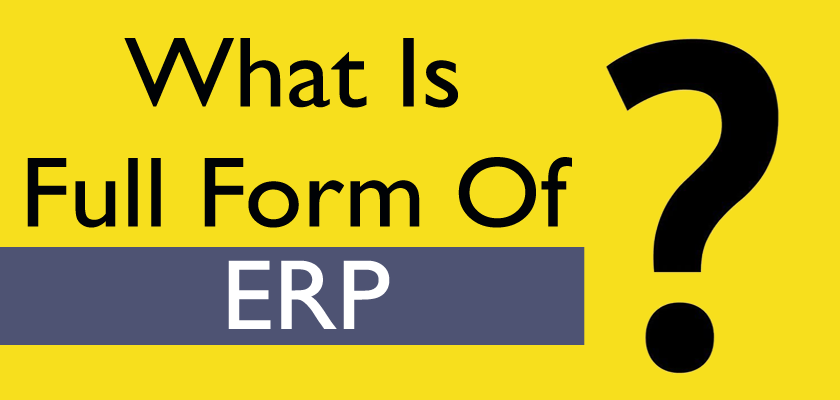Do you know what is the ERP Full Form? The full form of ERP is “Enterprise Resource Planning“. Enterprise resource planning (ERP) is an important software solution that businesses use to control key functions such as accounting, inventory, supply chain, human resources, and customer relationship management.
In this article, we will discuss the ERP Full Form and the importance of ERP systems in increasing efficiency and streamlining operations. We’ll explore the key features and components of ERP systems as well as the benefits of implementing them.
Table of Contents
What is the ERP Full Form?
ERP Full Form – Enterprise Resource Planning
What is Enterprise Resource Planning (ERP)?
Enterprise Resource Planning (ERP) is a type of software that companies use to control key operations like accounting, inventories, supply chains, human resources, and customer relationship management. ERP offers better visibility and control over operations by combining all of these processes into a single system. When corporations started employing computers to manage their back-office tasks in the 1960s, ERP was born. Software developers started developing more thorough methods for controlling business operations in the 1980s, which finally resulted in the development of ERP as we know it today.
Why Do Businesses Need ERP?
ERP systems assist enterprises in increasing efficiency, streamlining operations, and making better decisions based on up-to-date information. They do away with the requirement for several software systems for various business operations, which lessens the complexity and expense of administering many systems. Furthermore, ERP systems offer a single source of data truth, which can enhance accuracy and decision-making.
Key Features and Components of ERP
ERP systems have several key features and components, including:
- Financial management modules that help businesses manage accounting processes, such as accounts payable and receivable, general ledger, and financial reporting.
- Supply chain management modules that enable businesses to track inventory levels, manage orders and shipments, and coordinate with suppliers.
- Human resource management modules can help businesses manage employee information, track time and attendance, and automate payroll processes.
- Customer relationship management modules that provide tools for managing sales, marketing, and customer service processes.
Benefits of Implementing an ERP System
Implementing an ERP system offers several benefits, including:
- Improved efficiency and productivity by automating many manual processes, which can help businesses save time and reduce errors. ERP also provides real-time information, allowing employees to make decisions more quickly and effectively.
- Streamlined business processes by integrating all business functions into a single system, which can help eliminate duplicate data entry and improve communication between different departments. This can lead to faster turnaround times and more efficient processes.
- Enhanced data accuracy and decision-making by providing a single source of truth for data, which can help improve data accuracy and reduce the potential for errors. This, in turn, can help businesses make better decisions based on reliable information.
ERP Implementation Process
Implementing an ERP system involves several key steps, including:
- Assessing business needs and objectives by identifying key business processes, defining requirements, and determining which ERP system best fits the business’s needs.
- Vendor selection and contract negotiations by evaluating vendors based on criteria such as price, functionality, and support.
- System design and configuration by setting up the system, configuring workflows and approval processes, and defining user roles and permissions.
- Data migration and testing by carefully planning and testing to ensure data accuracy and consistency.
- Training and go-live by providing training and support to ensure that employees can use the system effectively and that the system meets the business’s needs.
Common Challenges in ERP Implementation
Implementing an ERP system can be a daunting task for businesses. Some of the most common challenges that companies face during implementation include:
- Resistance to change from employees who may be resistant to new technology or feel threatened by changes to their roles and responsibilities. To overcome resistance, it’s essential to involve employees in the implementation process from the beginning and clearly communicate the benefits of the new system.
- Data quality and integration issues arise due to inaccurate and integrated data from all business units. Investing in data management tools and processes can help mitigate these challenges.
- Cost overruns and delays that occur due to unforeseen customizations, data migration issues, or delays in testing and training. To prevent cost overruns and delays, it’s crucial to have a clear project plan with realistic timelines and budgets.
Differences between On-Premises and Cloud-Based ERP
Here are some key differences between on-premise and cloud-based ERP systems:
On-premises ERP:
- Requires businesses to invest in expensive hardware, software, and infrastructure
- Requires a dedicated IT staff for maintenance and updates
- Provides greater control over data security
- May have limited scalability and flexibility as resource allocation is fixed
- Can only be accessed on-site
Cloud-based ERP:
- Hosted off-site and accessed via the Internet, offering lower upfront costs
- Managed and maintained by the provider, reducing the need for IT staff
- Providers often have more robust security measures in place
- More scalable and flexible, allowing for easy adjustments to resource allocation and capacity
- Can be accessed from anywhere with an internet connection, increasing accessibility for employees.
Best Practices for Successful ERP Implementation
To ensure a successful implementation, businesses should follow these best practices:
Executive Sponsorship and Project Ownership
A successful ERP implementation requires executive sponsorship and clear project ownership from the beginning, with a dedicated project manager leading the effort.
Effective Communication and Change Management
Clear communication is essential throughout the implementation process, with regular updates to all stakeholders. Change management processes are also crucial to help employees adapt to new workflows and technologies.
Thorough Data Cleansing and Migration
To avoid data quality issues, it’s essential to conduct thorough data cleansing and migration before implementing the new system. This process should involve identifying duplicate or outdated data and ensuring data is correctly mapped and integrated into the new system.

Other ERP Full Forms List
If you want to know more about other full forms of ERP Word see the below table:
| Term | Full Form | Category |
| ERP | Enterprise Resource Planning | Software |
| ERP | Ear Reference Point | Computer and Networking |
| ERP | Effective Radiated Power | Computer and Networking |
| ERP | EOC Register Protocol | Computer and Networking |
| ERP | Event Related Potential | Chemistry |
| ERP | Extended Range Pyrometer | Electronics |
| ERP | Error Reduction Parameter | Maths |
| ERP | Equipment Reception Party | Military and Defence |
| ERP | Enroute Reporting Point | Military and Defence |
| ERP | Emergency Response Procedures | Messaging |
| ERP | Event Related Potentials | Physics Related |
| ERP | Eye Reference Point | Space Science |
| ERP | Exchange Rate Protection | Stock Exchange |
| ERP | Effective Rating Points | Sports |
| ERP | Early Racquet Preparation | Sports |
| ERP | Enhanced Realistic Personality | Sports |
| ERP | Envelope Return Path | Software |
FAQs- What Is The ERP Full Form?
Q.1. What is ERP Full Form?
Ans. The ERP Full Form is “Enterprise Resource Planning.”
Q.2. What is ERP?
Ans. ERP is a type of software solution that businesses use to manage and control key operations like accounting, supply chains, inventories, human resources, and customer relationship management.
Q.3. Why do businesses need ERP?
Ans. ERP systems help businesses increase efficiency, streamline operations, and make better decisions based on up-to-date information. They also offer a single source of truth for data, which can enhance accuracy and decision-making.
Q.4. What are the key features and components of ERP?
Ans. ERP systems have several key features and components, including financial management, supply chain management, human resource management, and customer relationship management modules.
Q.5. What are the benefits of implementing an ERP system?
Ans. Implementing an ERP system offers several benefits, including improved efficiency and productivity, streamlined business processes, and enhanced data accuracy and decision-making.
Q.6. What is the ERP implementation process?
Ans. The ERP implementation process involves several key steps, including assessing business needs and objectives, vendor selection and contract negotiations, system design and configuration, data migration and testing, and training and go-live.
Thanks for reading What is the ERP Full Form? Bookmark our website Whatisfullform.com to know or read our collection of full forms.


